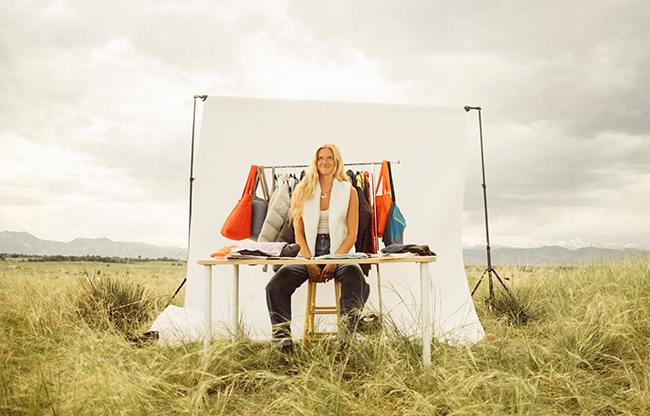Colorado Flood
01 Dec 2013
Colorado Flood Unique, but not the BIG ONE
By Shannon Burgert The September 2013 rain and flood have gathered a lot of labels, from “biblical” to “thousand-year event.” Some labels may have been brandished prematurely.One that sticks well? “Unprecedented.”
A weather balloon launched at the old Stapleton Airport location on the morning of Sept. 11 indicated that the atmosphere was holding more moisture than at any other time on record during the month of September. That moisture, coinciding with the peak of the tropical storm season, originated over the Gulf of Mexico and from the tropical Pacific southwest of Mexico. The moisture moved up from the south, packed itself up against the foothills and rose in an upslope—an effect common in the foothills, but not in September. To top it off, the saturated air bumped up against a push of cooler air from the northeast. The storm system was blocked, and so it persisted, repeatedly pushing up against the foothills. It covered an enormous area, from northern Mexico to southeast Wyoming.
“It was a big system,” says Nolan Doesken, the state climatologist at Colorado State University. It had a very efficient condensation process, too, he says. Rather than coming in the large, cold drops typical of a summer thunderstorm, much of the rain arrived in many small but warm drops.
The air was still warm, and thus the precipitation fell as rain all the way up to the Continental Divide. And the rain was falling on watersheds that were already saturated from rains earlier in the week. In less than seven days, the city of Boulder received more than 17 inches of rain, rocketing above September’s typical 1.68 inches and approaching the area’s yearly average of 18.64 inches; the deluge was concentrated between the evening of Wednesday, Sept. 11, and the morning of Friday, Sept. 13. The 9.08 inches that fell in Boulder on the 12th almost doubled the previous one-day record for the city, 4.80 inches on July 31, 1919.
‘That water was hauling’
Looking up and down the Front Range, the distance from the Continental Divide to the plains is shortest in Boulder County. It was a lot of rain to funnel into relatively small rivers and streams in the canyons. Flood damage increases with depth and velocity, and “that water was hauling,” says Doesken. But while floods often peak and then start to recede after an hour or two, the streams in Colorado remained high for several days. And this led to one of many features of the September flood that were unprecedented: Rivers carved new paths. “Every hour that water is high and fast, there is more rechanneling, doing geologic work very effectively,” says Doesken. “They were not just short, quick peaks. They were large, long surges.”
Little peak-flow information has been available because most of the stream gauges, in Kevin Stewart’s words, “took a riverboat ride”—a $350,000 loss. Stewart is a manager with the Urban Drainage and Flood Control District. Experts from agencies such as the U.S. Geological Survey and the U.S. Department of Agriculture have been working to reconstruct peak flow numbers on the basis of high-water marks. Doesken says that while numbers are still yet to be established, the South Platte itself spread more than a mile wide as its flooded tributaries hit it, one by one. “It was almost like the Missouri River, definitely over 50,000 cfs [cubic feet per second] downstream from Greeley,” Doesken says.
Don’t sell the ark just yet
As for categorizing the event, “it’s a different answer for every location on every river,” Doesken says. Overall, it was roughly a 25-year event, according to Robert Jarrett, scientist emeritus for the U.S. Geological Survey, and Dan Barber, deputy director of the Boulder Office of Emergency Management. The rains over Boulder, however, indeed can carry the label “1,000-year rainfall,” and some streams and rivers, like Coal Creek and the St. Vrain, exceeded 100-year flood levels.
At its peak, Boulder Creek was flowing at a little over 5,000 cfs. As a comparison, average flow for the creek is 100-300 cfs, though an average flow of 10 cfs is typical in December; during a 100-year flood, the creek’s flow would reach 12,000 cfs. (The term “100-year flood” can be misleading. It is a flood that has a 1 percent chance of occurring in any given year. A 25-year flood, then, has a 4 percent chance of happening each year.)
“I actually heard the term being thrown out that this was a ‘biblical’ flood, and to me it was absolutely nothing of the sort,” says Kevin Houck, chief of the Watershed and Flood Protection Section of the Colorado Water Conservation Board. However, he says, “I cannot believe how widespread some of these rainfall totals are. … But when you look at actual stream flows, they’re nowhere near that 1,000-year-type event that a lot of people were talking about. We can and likely will see a lot worse than this eventually.”
How well-prepared were we?
Norm Ashford is a National Flood Insurance Program specialist for the six-state region that includes Colorado. Relative to flood events in other parts of the country, Colorado filed a small number of claims, he says. But the flood was spectacular, Ashford says, in terms of the roads that were washed away, the communities that have been isolated, the number of people rescued by helicopter, and the water cascading down the mountains.
The fact that the number of fatalities—four in Boulder County and nine in the state—wasn’t higher is a miracle, says Barber. He attributes the small number of deaths to the best detection and warning systems available, strong partnerships with the National Weather Service and the Urban Drainage and Flood Control District, and planning and practicing for such an event since the Big Thompson flood in 1976. Barber notes that Boulder’s efforts to prepare channels and bridges for a flood also paid off.
Preparedness has been particularly high in burn areas, such as the 2010 Fourmile burn area, because fires change watershed characteristics and increase flood risk. “I give fire districts a tremendous amount of credit,” says Stewart, because the education and planning in the Fourmile area were exhaustive. Stewart adds, “The fact that we did not have fatalities in an area we were concerned about is a celebration.”
But the relatively low number of fatalities can also be attributed to the fact that it wasn’t “the big one,” says Jarrett. “As traumatic as it was last month, it was no flash flood,” he says. Looking at the Big Thompson Flood in 1976 as a comparison, while Boulder County got about a foot of rain over a period of 40 hours, the Big Thompson river basin area got about a foot in four hours, including 7.5 inches in one hour. While we have come a long way since Big Thompson in terms of preparedness and warning systems, Boulder has far greater numbers of people at the bottom of the 13 watersheds that run west-to-east across its landscape, earning it the distinction of most at-risk city in Colorado for flooding.
“I don’t know if they just keep winning the lottery [in Boulder] or something,” Houck says, “but for reasons I can’t explain, they just have not had a lot of really, really damaging floods in an area that should be very flood-prone.”
Regardless, flood experts hope that rather than become complacent and assume that they’re safe from flooding for a while, people will instead take heed and become better prepared. That includes purchasing flood insurance (anyone in Boulder County is eligible through the National Flood Insurance Program), making emergency plans with their families, signing up for alerts (see www.boco911alert.com), and always paying attention to the weather.
What’s to come?
Effects from this flood will most likely last for years. In the short term, the water table is up, and that will likely lead to increased spring runoff. That’s good news for the water supply, but it presents a higher risk for spring flooding.
Floodplain maps had been updated just a year before the flood, and according to Houck and Barber, they were accurate for the streams pre-flood, and predicted reasonably well where floodwaters would reach. But the floodplain has now changed because of the shifted stream channels, Barber says. “That’s a problem,” and the maps will need to be reexamined.
Rebuilding is likely to take a few years, and there are many questions as yet unanswered. Among the big questions is how to deal with the rechanneled rivers. Temporary fixes are crucial in some cases, says Barber, because the rivers are necessary for agricultural irrigation and as water sources. But long term, Barber voices the question that many in Colorado—from local communities to the U.S. Army Corps of Engineers to the Colorado Division of Wildlife—are asking: “Should we honor Mother Nature or should we put the rivers back to where they were, knowing that 10, 20, 30 years from now they will probably follow their natural courses again?” The fact that the streams and rivers flow through a lot of private land only complicates an already complex problem.
“I think there’s going to be challenges that we’re facing following this event that in their entirety have never been faced before,” says Houck. “So I think it’s going to be a really good test case, a petri dish for the country, if you will, to see how things end up recovering. It will be very interesting to see, five years from now: Are we in a better place than we were before, or did we end up rushing the recovery?”
As for more-frequent flood events to come? Lottery tickets aside, the scientific community is not at all convinced that the September rainfall was climate change–related, says Doesken. What he can say with confidence, though, is that when the atmosphere is warmer, it has the potential to hold more water.
But anomalies, as Houck points out, are normal.
Shannon Burgert is a fifth-grade teacher in Louisville. She previously wrote about Boulder’s flood risk in the Winter 2005/Spring 2006 edition of Boulder Magazine. Along with 78 fifth graders and 13 other adults, Burgert was evacuated by the National Guard on Sept. 14 from the Cal-Wood Education Center near Jamestown.












